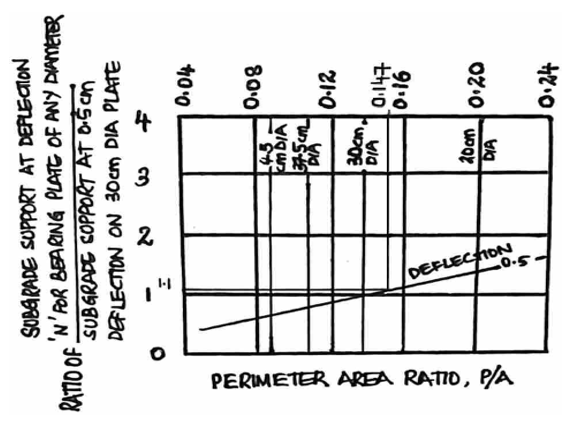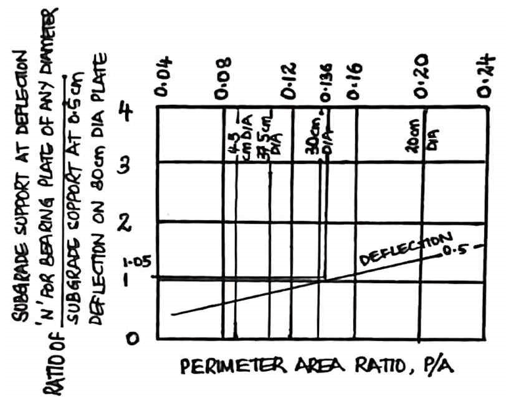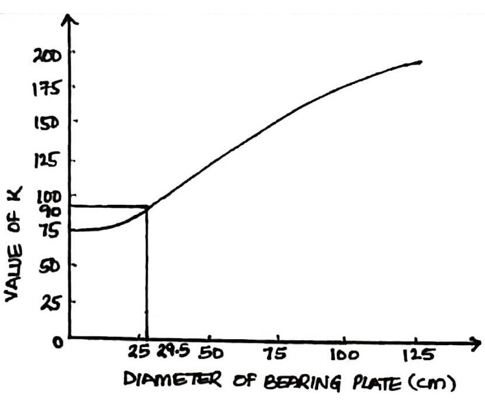This set of Pavement Design Multiple Choice Questions & Answers (MCQs) focuses on “McLeod and Burmister Method – 1”.
1. McLeod method is based on the test results of ______ test.
a) Bearing stress
b) Plate load
c) Effective stress
d) Direct shear
View Answer
Explanation: McLeod is an empirical method used for the design of flexible pavements. The results from the plate load bearing test are used for the McLeod method. Bearing stress is not a test, it’s a strength parameter. The shear test is not used to compute the bearing capacity of the soil.
2. Burmister’s method can be considered as a special case of Boussinesq’s theory.
a) True
b) False
View Answer
Explanation: Both methods use the modulus of elasticity of the various layers of the pavement. In Boussinesq’s method, the relation between E value of the layers subgrade, sub-base and base can be written as \(E_s=E_sb=E_b\) and as per Burmister’s method, \(E_b >E_sb>E_s\). Hence, Burmister’s method can be considered as a special case of Boussinesq’s theory.
3. What is the equation for the thickness of pavement using McLeod method of design?
a) \(T=log_{10}\frac{P}{s}\)
b) \(T=K log_{10}\frac{P}{s}\)
c) \(T=k log_{10}\frac{PE}{s}\)
d) \(T=log_{10}\frac{PE}{s}\)
View Answer
Explanation: For computing the thickness of gravel base using McLeod method is given by \(T=K log_{10}\frac{P}{s}\). The equation uses the base course constant, the wheel load and the subgrade support.
4. The surface layer is considered to be ______ in the vertical direction.
a) Infinite
b) Finite
c) Inelastic
d) Heterogeneous
View Answer
Explanation: The surface layer is considered to be infinite in the horizontal direction and finite in the vertical direction. The surface layer is the topmost layer and hence it has a particular thickness and it extends infinitely along the horizontal direction. It is elastic and is homogeneous.
5. The design subgrade support can be obtained by ______ the ratio and the ______
a) Multiplying, bearing stress
b) Multiplying, contact pressure
c) Adding, bearing stress
d) Adding, contact pressure
View Answer
Explanation: In order to compute the design subgrade support, there are design charts available. The ratio of design subgrade support to the standard subgrade support is obtained from the chart and the ratio is found out. On multiplying the ratio by the contact pressure of the design load, the design subgrade support can be found out.
6. What will be the subgrade support for a wheel load of 4100 kg and tyre pressure of 7 kg/cm2 if the subgrade soil is subjected to plate load bearing test using 30 cm diameter plate and it yielded a pressure of 2.5 kg/cm2 after ten repetitions of load at 0.5 cm deflection?
a) 2.75 kg/cm2
b) 2.2 kg/cm2
c) 1.1 kg/cm2
d) 1.75 kg/cm2
View Answer
Explanation: The radius of the contact area can be found out using the relation between wheel load (P), tyre pressure (p) and radius (a) as \(πa^2=\frac{P}{p}\). So, the radius of the contact area can be obtained as
\(a=(\frac{P}{pπ})^{1/2}=(\frac{4100}{7×π})^{1/2}=13.65 cm\)
In order to find subgrade support, perimeter area ratio and the plate load test details are required. The perimeter area ratio can be obtained as
\(\frac{P}{A}=\frac{2πa}{πa^2}=\frac{2}{a}=\frac{2}{13.65}=0.147\)
The design chart defined by Norman W. McLeod through the Canadian Department of Transport is used. A sample is shown below with the details for 0.5 cm deflection. The ratio for subgrade is obtained as 1.1 from the same.

Therefore, the design subgrade support is = Ratio obtained from chart X contact pressure of design load = 1.1 X 2.5 = 2.75 kg/cm2.
7. Find the thickness of the pavement using McLeod method for the soil subgrade having following details:
Wheel load, P = 4100 kg
Tyre pressure, p = 5 kg/cm2
Total subgrade support, S = 1810 kg
Base course constant, K = 85
a) 31 cm
b) 30 cm
c) 28 cm
d) 29 cm
View Answer
Explanation: The equation for the thickness of pavement using McLeod method is \(T=K log_{10}\frac{P}{s}\).
From the question, P = 4100 kg; K = 85 and S = 1810 kg
\(T=85 log_{10}\frac{4100}{1810}\)=30.18 cm≈30 cm
8. What is the deflection factor for a single layer in Burmister’s equation?
a) 2
b) 0.5
c) 0
d) 1
View Answer
Explanation: For a single layer, the pavement thickness or the thickness of the reinforcing layer, h is taken as 0. In the design chart, the value of the ratio of deflection factor is read for h/a = 0 and modulus of elasticity 1. It is obtained as 1.
9. Find the thickness of the pavement using McLeod method for the soil subgrade having following details:
Wheel load, P = 4100 kg
Tyre pressure, p = 6.5 kg/cm2
Total subgrade support, S = 2050 kg
Base course constant, K = 80
a) 25 cm
b) 24 cm
c) 23 cm
d) 22 cm
View Answer
Explanation: The equation for the thickness of pavement using McLeod method is \(T=K log_{10}\frac{P}{s}\).
From the question, P = 4100 kg; K = 80 and S = 2050 kg
\(T=80 log_{10}\frac{4100}{2050}\)=24.08 cm≈24 cm
10. Design a pavement for a wheel load of 4100 kg and tyre pressure of 6 kg/cm2 . Plate load bearing test using 30 cm diameter plate is done on the soil and it yielded a pressure of 3 kg/cm2 after ten repetitions of load at 0.5 cm deflection?
a) 25 cm
b) 24 cm
c) 35 cm
d) 34 cm
View Answer
Explanation: The radius of the contact area can be found out using \(πa^2=\frac{P}{p}\)
\(a=(\frac{P}{pπ})^{1/2}=(\frac{4100}{6×π})^{1/2}=14.75 cm\)
To find unit support, perimeter area ratio and the plate load test details are required. The perimeter area ratio can be obtained as
\(\frac{P}{A}=\frac{2πa}{πa^2}=\frac{2}{a}=\frac{2}{14.75}=0.136\)
The design chart developed by Norman W. McLeod through the Canadian Department of Transport is used. A sample is shown below with the details for 0.5 cm deflection line. The ratio for subgrade is obtained as 1.05 from the chart.

Therefore, the unit support or the design subgrade support is = Ratio obtained from chart X contact pressure of design load = 1.05 X 3 = 3.15 kg/cm2. The total subgrade support, S is obtained by multiplying unit support by the contact area.
S=3.15×π×(14.75)2=2153 kg
To find the base course constant for diameter 29.5 cm (2X14.75 cm), another design chart given by McLeod is used. The sample graph is as below.

Therefore, K = 90
The thickness can be found out as \(T=K log_{10}\frac{P}{s}\)
\(T=90 log_{10}\frac{4100}{2153}\)=25.18 cm≈25 cm
Sanfoundry Global Education & Learning Series – Pavement Design.
To practice all areas of Pavement Design, here is complete set of 1000+ Multiple Choice Questions and Answers.
If you find a mistake in question / option / answer, kindly take a screenshot and email to [email protected]
- Check Pavement Analysis and Design Books
- Check Civil Engineering Books
- Practice Civil Engineering MCQs
- Apply for Civil Engineering Internship
